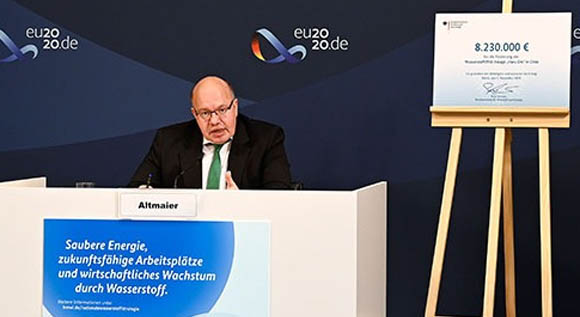Green hydrogen from Chile using technology 'Made in Germany'
A pilot project in sunny and windy Chile aims to show whether and how green hydrogen can be produced sustainably there and marketed globally. Innovative technologies and processes 'Made in Germany' will come into play.
 © BMWi/Andreas Mertens
© BMWi/Andreas Mertens
Chile stretches 4,300 kilometres along the Andes and the Pacific coast, with plenty of sunny desert areas and lots and lots of wind in between. Given these conditions, the South American country has a lot of potential to generate hydrogen from wind, hydropower and the sun, and hopes soon to emerge as a major exporter of green hydrogen (in German only). Hydrogen is regarded as a key priority for the realisation of the energy transition, particularly in some industrial and transport sectors where it is difficult to cut emissions. Germany could be a market for climate-neutral Chilean hydrogen.
The 'Haru Oni' power-to-X project is the first international green hydrogen project to receive funding from the stimulus package by the Economic Affairs Ministry as part of the National Hydrogen Strategy. In early December, Economic Affairs Minister Peter Altmaier presented Siemens Energy with an approval notice worth €8.23 million for this project, and said: 'German companies are at the very forefront of global hydrogen technologies. The ‘Haru Oni’ project is a good example of this. The project demonstrates that it is possible to sustainably produce green hydrogen and its derivatives with the help of the latest technologies 'Made in Germany', for instance in Chile.
Siemens Energy is developing the world’s first integrated commercial installation for the production of climate-neutral fuel near the Patagonian city of Punta Arenas in the south of Chile. The synthetic fuel (eFuel) is to be made from hydrogen produced using wind power and the CO2 captured from the air. Background: as Germany’s ramps up hydrogen production for the market, it is counting not only on a strong domestic market, but also on pilot projects conducted by German firms in partner countries where green hydrogen and its derivatives can be produced efficiently and at a low cost. The Chilean project could also help Germany to build up reliable import capacities and to position German firms on this forward-looking market.
The ‘Haru Oni’ PtW project translates innovative technologies and processes fresh from the lab right into application. In the pilot phase, some 130,000 litres of eFuel will be generated in 2022. The capacity is then to be raised to around 55 million litres of eFuel a year by 2024, and around 550 million litres by 2026. The objective is to implement these technologies on an industrial scale. In addition to Siemens, further international partners will be involved in the project, including the German firm Porsche AG as a client for the synthetic fuel.
The Chilean project is the first hydrogen-related project under the National Hydrogen Strategy to receive funding from the Stimulus and Future Package. The package earmarks a total of €9 billion for the implementation of the National Hydrogen Strategy, including €2 billion for international projects in selected partner countries. Chile and Germany have been linked by a bilateral energy partnership since 2019. Energy partnerships facilitate an energy-policy dialogue at governmental level and provide impetus for energy-policy innovation and for economic cooperation on the path towards a global energy transition.
Further information
- Press release by the Federal Ministry for Economic Affairs and Energy: 'Haru Oni PtW project: Minister Altmaier hands over first approval notice for international green hydrogen project'
- Video from the Federal Ministry for Economic Affairs and Energy: 'Press conference marking the handing over of an approval notice for funding for a green-hydrogen installation in Chile' (in German only)
- Further information about the energy partnership between Germany and Chile
- Publication by the Federal Ministry for Economic Affairs and Energy 'The National Hydrogen Strategy'
- Federal Ministry for Economic Affairs and Energy dossier: Hydrogen: a key element for the energy transition (in German only)

